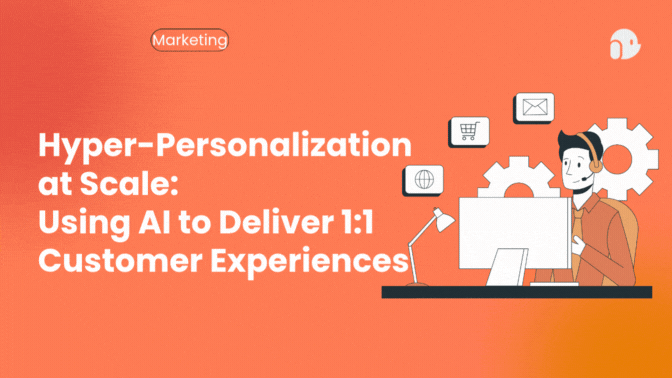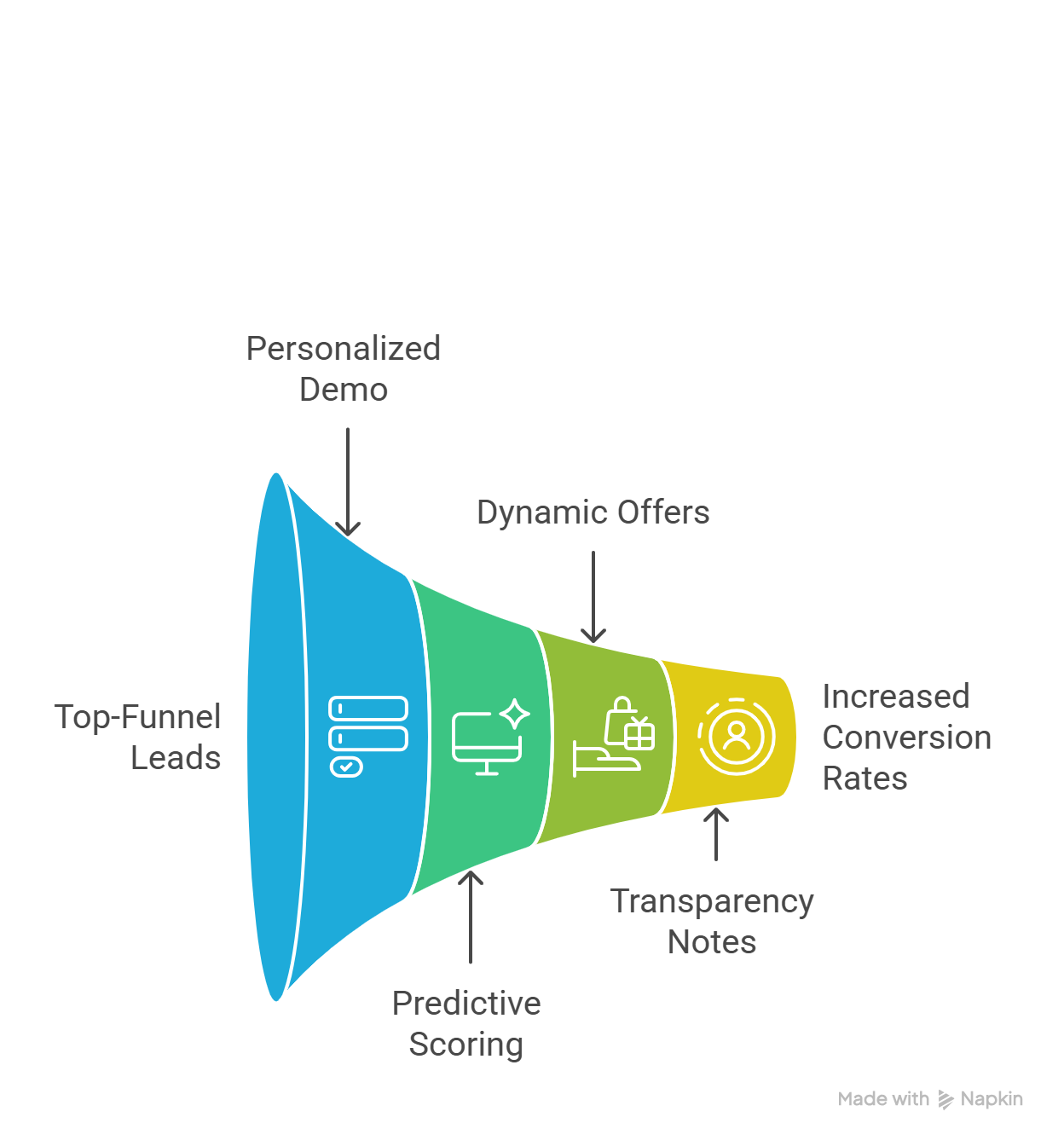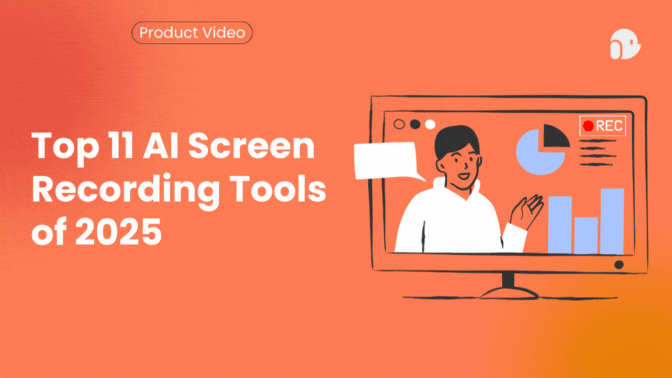Hyper-Personalization at Scale: Using AI to Deliver 1:1 Customer Experiences

Buyers today expect brands to feel less like billboards and more like personal assistants. They want the right message at the right time, not a generic blast that screams “sent to 10,000 people.” Hyper-personalization is the method (and the promise): using AI to transform one-size-fits-all marketing into genuine, one-to-one conversations. Sounds expensive? It used to be. Today, with smarter infrastructure and demo automation, it’s achievable and measurable.
What hyper-personalization actually means
Think of traditional personalization as addressing a customer by name and recommending last month’s popular product. Useful, but shallow. Hyper-personalization dives deeper: it uses real-time signals (browsing behavior, time of day, device, even weather) and predictive analytics to anticipate needs before the customer explicitly asks.
In short, the unit of targeting moves from a segment to the individual. That’s a big difference in how teams plan, measure, and execute.
If you’re curious about how personalization aligns with broader SaaS product marketing strategies, check out How to Excel in SaaS Product Marketing for B2B SaaS Companies. It explains how positioning, messaging, and personalization intersect to influence customer decisions.
The AI engine behind 1:1 experiences
AI is no longer a buzzword it’s the engine. Predictive models learn continuously from new data to recommend the next-best action. NLP interprets sentiment in feedback and search queries. Deep learning processes multimodal signals (text, images, video). Generative AI removes the content bottleneck by creating personalized emails, product copy, images, and crucially for product teams personalized demo videos on the fly.
Example: a retail app might use purchase history, session activity, and local weather to push a small, timely offer. A more powerful use case for product marketers is an automated demo video tailored to the exact features a prospect explored during a free trial.
If you’d like to explore how AI can connect product development, marketing, and sales in a unified motion, read AI-Powered GTM Strategies: Bridging the Gap Between Product Development and Sales. It’s a great complement to understanding how hyper-personalization fits within the go-to-market ecosystem.
Infrastructure you can’t ignore (but you can start small)
Two pieces matter most: a unified Customer Data Platform (CDP) and low-latency decisioning. The CDP builds the 360° profile; the decision engine turns signals into actions. Why does latency matter? Because predictions are only valuable if they reach the user while the context still matters — think milliseconds, not minutes.
If that sounds daunting, here’s a pragmatic entry point for smaller teams:
- Start with a CDP-lite: consolidate the most important signals (trial events, page visits, key form fills).
- Automate one high-impact use case (personalized demo videos or dynamic onboarding emails).
- Measure — then scale the infra as the ROI becomes clear.

A practical playbook for product marketers & presales
Want hands-on moves you can try this quarter? Here are five actionable plays:
- Automate a 1:1 demo for your top-funnel leads. Use screen recordings or event data to generate a 30–60s personalized demo that shows the features a prospect actually used.
- Use predictive scoring to prioritize outreach. Let AI flag leads most likely to convert and route them to solutions engineers faster.
- Test small dynamic offers. Run controlled experiments on time-limited incentives, keeping a close eye for price fairness and customer sentiment.
- Publish explainability notes. For critical decisions (pricing, limits), tell users why they got an offer transparency builds trust.
- Track the right metrics. Focus on demo→trial conversion, demo CTR, ARPU lift, and opt-in rates for personalization.

Trust, governance, and ethics — non-negotiables
Hyper-personalization trades on intimacy with user data, so governance is business-critical. Implement clear consent flows, keep an auditable trail for model decisions, and schedule algorithmic bias audits. Explainable AI (XAI) techniques help translate model logic into business language and into customer-facing transparency where appropriate.
Remember: short-term gains from aggressive price discrimination or opaque targeting can destroy long-term loyalty.
Why demo automation matters (and where puppydog.io fits)
Content creation used to be the bottleneck for personalization. Generative AI fixed the asset side, and demo automation fixes the product demo gap. Imagine sending a prospect a bespoke demo video that highlights exactly the screens they used in a free trial generated automatically from a screen recording or screenshots. That’s not hypothetical; it’s what demo automation platforms do today.
Personalized demo videos increase relevance, shorten sales cycles, and provide a measurable lift in demo engagement and conversion. For product marketers and presales teams, that’s a direct path to better ARPU and lower cost-to-serve.
Conclusion start with impact, scale responsibly
Hyper-personalization is no longer optional. When done right with fast, well-governed infrastructure and smart AI it drives real revenue uplift and deeper customer loyalty. But the biggest wins come from combining technology with pragmatic plays: automate one high-value customer touch, measure the outcome, and scale ethically.
Want to see it in action? Generate a personalized demo sample with puppydog.io and watch what a 30–60 second tailored walkthrough does for your conversion metrics.
Frequently Asked Questions (FAQs)
Q: What exactly is hyper-personalization? Hyper-personalization uses real-time data and AI to tailor experiences to individual users — not just segments. It predicts needs and delivers context-aware content at the moment it matters.
Q: How is hyper-personalization different from traditional personalization? Traditional personalization is reactive and often limited to basic signals (name, past purchases). Hyper-personalization is proactive, using predictive analytics, NLP, and deep learning to create truly 1:1 interactions.
Q: Do small teams or SMBs need to invest in HP? Not immediately at full scale. Start with one high-impact use case (like personalized demo videos or tailored onboarding), measure results, and then expand. Many ROI-friendly wins exist without massive infrastructure investment.
Q: Is hyper-personalization privacy-intrusive? It can be if done carelessly. Best practice is consent-first data collection, transparent disclosures, and giving customers easy opt-out controls — all while using anonymization and secure storage.
Q: How should I measure whether HP is working? Track demo→trial conversion, demo engagement (CTR/watch rate), ARPU lift, cost-to-serve reduction, and opt-in/consent rates. Combine short-term conversion metrics with longer-term loyalty indicators.
Q: How does puppydog.io help with hyper-personalization? puppydog.io automates the creation of personalized demo videos from screen recordings or screenshots, solving the content bottleneck and enabling product teams to deliver tailored walkthroughs at scale.
Q: How do I get started right away? Pick one customer journey stage (e.g., trial follow-up), generate a sample personalized demo for a small segment, measure the lift, and iterate. If you'd like, we can help you generate a demo sample to test on real leads.
Further Reading
Explore more resources to deepen your understanding of hyper-personalization, AI, and customer experience strategies:
- How to Deliver Customer Experience Personalization with a CDP — CDP.com
Discover how a Customer Data Platform unifies customer data, breaks down silos, and delivers real-time personalization across every marketing channel. - Purplle Case Study | Google Cloud
Learn how the beauty e-commerce platform Purplle leverages Google Cloud’s real-time data pipelines to deliver highly personalized product recommendations at millisecond latency. - What Is Real-Time Personalization? | Salesforce
A clear breakdown of real-time personalization — what it means, the technology behind it, and why speed and unified customer profiles are critical for success. - Leveraging Artificial Intelligence for Hyper-Personalized Marketing: Opportunities and Challenges in the Digital Era — Inverge Journal of Social Sciences
A scholarly exploration of how AI enables hyper-personalized marketing while addressing key challenges like ethics, data privacy, and implementation scalability.

Sarah Thompson is a storyteller at heart and Business Developer at PuppyDog.io. She’s passionate about creating meaningful content that connects people with ideas, especially where technology and creativity meet.






